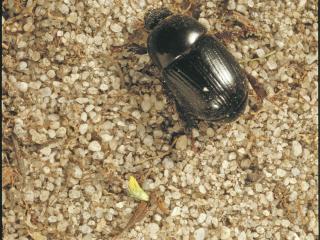African black beetle
Symptoms
The main difference between dry patch and lawn heavily infested by African black beetle (Heteronychus arator) is that, in the latter case, the damaged turf can be rolled back like carpet. It is the grubs, not the adult beetles, which are the more voracious feeders, literally cutting the grass off at its roots.
Treatment
Products containing cyfluthrin and bifenthrin, synthetic pyrethroids or chlorphyrifos control both the beetle and grubs.
Imidacloprid, sometimes combined with small quantities of cyfluthrin, is a low toxicity grub killer, as is neem extract. Some lawn fertilisers also contain insecticides like bifenthrin.
Pesticide should be used only for severe infestations where lawn damage is unquestionably due to African black beetle. There is some debate about how many beetles per square metre constitute a severe infestation, but it is possible to have a large number of beetles living in the lawn without seeing any damage.
To test for the presence of African black beetle pour a bucket of soapy water onto the affected areas to flush the beetles and their larvae to the surface.
Adult beetles will congregate under a moistened hessian bag or an old piece of carpet placed on the lawn at the end of the day. When the matting is lifted next morning, the beetles can be collected, put into a sealed bag and thrown in the bin. The adult beetles are nocturnal and are often drawn to garden lights where they are easy targets for collection.


